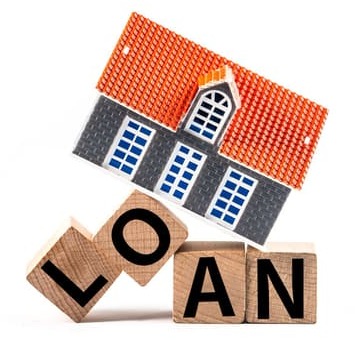Repaying a home loan can be challenging, and there are times when you might struggle to make your monthly loan payments, also known as EMIs, on time. These late payments not only have a negative impact on your credit score but also result in additional charges or penalties. Recently there is a lot of discussion on ‘Home Loan With Overdraft Facility’ as a way to reduce interest costs without sacrificing liquidity. As a financial guide, Simple Path brings to you a detailed article on all you need to know about Home Loan With Overdraft Facility.
What is Home Loan with Overdraft Facility?
 A home loan overdraft functions similarly to an overdraft limit on a current or savings account, where borrowers can deposit additional or advanced funds. With a home loan overdraft facility, the borrower’s loan account is linked to a dedicated savings account provided by the lender. When the borrower adds surplus money to this account, it is considered a pre-payment towards the home loan, which results in a reduction in the interest charged on the outstanding loan amount. Essentially, this helps decrease the overall liability, as interest is only applied to the remaining balance.
A home loan overdraft functions similarly to an overdraft limit on a current or savings account, where borrowers can deposit additional or advanced funds. With a home loan overdraft facility, the borrower’s loan account is linked to a dedicated savings account provided by the lender. When the borrower adds surplus money to this account, it is considered a pre-payment towards the home loan, which results in a reduction in the interest charged on the outstanding loan amount. Essentially, this helps decrease the overall liability, as interest is only applied to the remaining balance.
Moreover, the overdraft option allows borrowers to withdraw money as needed, typically for one-time expenses like medical emergencies, household expenses, or weddings. The loan balance is adjusted accordingly. One significant advantage of this scheme is the liquidity it offers. However, it’s important to note that any increase in the outstanding balance of the home loan can subsequently raise the interest rate.
Nevertheless, interest will only be charged on the amount withdrawn that exceeds the account balance, and it will be applicable for the period it was drawn. To mitigate risk, lenders typically impose a limit on the withdrawal amount, often around 25% of the loan amount, although this may vary based on each bank’s internal policies.
For Whom Does The Home Loan Overdraft Facility Work?
Home Loan Overdraft is particularly beneficial for individuals who are confident in their ability to save extra money on top of their regular EMIs. Once you opt for the overdraft scheme, you can conveniently transfer the funds from your savings account directly to your home loan account.
For borrowers with a home loan overdraft facility, the calculation of home loan interest costs is done by deducting the amount deposited in their linked savings or current account from the outstanding home loan amount. This means that borrowers can choose to keep their emergency funds in the linked overdraft account. Borrowers have the freedom to deposit or withdraw funds multiple times during the loan tenure, providing flexibility in managing their cash flow.
Illustration of Overdraft Facility Concept
In January 2019, Mr. Sharma obtained a home loan of ₹80 lakh from PNB Housing Finance Limited for a tenure of 20 years at an interest rate of 8.6%. Based on this, his monthly equated monthly instalment (EMI) will be ₹70,000.
Now, let’s assume that Mr. Sharma has a surplus of ₹4 lakh and decides to make a partial payment after 24 regular EMIs to reduce his overall loan amount.
In a regular home loan, prepaying the extra funds would keep the EMIs unchanged, and the principal-interest ratio would remain the same. However, in the case of a home loan overdraft, if Mr. Sharma deposits ₹4 lakh into the account linked to his home loan, the EMI will reduce to ₹66,000 from the following month, effectively decreasing the loan tenure.
This is because the interest on a home loan overdraft is calculated based on the outstanding principal amount. Therefore, the more money Mr. Sharma puts into his account, the more he reduces the interest outgo on his loan. Simple!
Advantages of Home Loan with Overdraft Facility
The popularity of the overdraft facility in home loans as an investment option is increasing, and it’s important to understand the reasons behind this trend.
1. Flexibility to withdraw surplus funds:
Overdrafts provide high liquidity, allowing you to withdraw money from your account up to a predetermined limit. You can make multiple withdrawals at your convenience, which can be extremely useful during financial emergencies. This flexibility allows you to utilize your savings account to cover additional expenses. It is particularly beneficial for those who are not facing a cash crunch. By using the overdraft facility, you can avoid prepayment penalties and reduce the overall interest cost.
2. Avoidance of prepayment penalties:
With an overdraft home loan, you can steer clear of prepayment penalties. This means you can avoid the high costs associated with paying off your loan in advance while still having the option to use the account when needed. However, it’s important to exercise caution to avoid incurring hefty fees for exceeding the preset withdrawal limit from your savings account. By opting for an overdraft home loan, you can eliminate these penalties altogether.
3. Option to repay the loan before the agreed tenure:
One significant advantage of an overdraft home loan is the ability to repay the loan before the predetermined tenure. This gives you the flexibility to clear your debt earlier than planned, potentially saving on interest payments and achieving financial freedom sooner.
In summary, an overdraft facility in a home loan provides the flexibility to withdraw surplus funds, helps avoid prepayment penalties, and allows for early loan repayment. These advantages make it an attractive option for borrowers seeking greater financial control and flexibility in managing their home loan.
Drawbacks of Home Loan with Overdraft Facility
While the overdraft facility in a home loan can be beneficial for some, it’s important to recognize that it may not be suitable for everyone due to certain limitations. Here are some of the disadvantages to consider:
1. Not ideal for saving:
The primary drawback of overdraft home loans is that they are not advantageous for individuals looking to save money. If you rely on the overdraft facility for regular expenses, it can become expensive in the long run. Moreover, borrowers who struggle to maintain their current financial situation may find it challenging to repay the entire borrowed amount in a lump sum.
2. Higher interest rates:
Although the flexibility to use funds when needed is attractive, it often comes at a higher cost. Overdraft home loans typically carry relatively higher interest rates compared to standard conventional home loans. For example, while a regular home loan may have an interest rate of 6.8% per annum, a home loan with an overdraft facility could charge around 7.2% per annum. As a result, it’s crucial to pay off these loans quickly to minimize interest payments. It’s important to compare the interest rates of both options before making a final decision.
3. Lack of tax benefits:
If you file your income tax based on the old tax regime, the overdraft facility does not provide tax benefits under section 80C for additional payments made on the home loan. The surplus amount deposited into the overdraft account does not qualify for tax deductions.
It’s essential to carefully evaluate these disadvantages in relation to your financial goals and circumstances before deciding on a home loan with an overdraft facility. Assessing the long-term costs, interest rates, and tax implications will help you make an informed choice.
Key Differences with Regular Home Loan
| Regular Home Loan | Home Loan with Overdraft Facility |
| The outstanding principal amount | The book balance (calculated as outstanding loan amount + surplus funds available in the home loan overdraft account) |
| The surplus amount paid towards home loan prepayment is automatically deducted, making them unavailable for withdrawing | The surplus amount added to the overdraft account can be withdrawn anytime. |
| When the home loan is paid off, the amount outstanding becomes zero | The book balance becomes zero when the entire amount is paid off (loan amount + overdrawn amount) along with interest. |
| Prepayment reduces your balance outstanding | Prepayment increases your available balance and reduces the outstanding amount. |
Should You Opt for Home Loan Overdraft Facility or Regular Home Loan
 Choosing between an overdraft and a regular home loan depends on your personal use and financial situation. If you anticipate needing funds in the future for purposes like your child’s education or home improvements, an overdraft facility can be advantageous. However, it’s important to use it responsibly and avoid using it for non-essential purchases.
Choosing between an overdraft and a regular home loan depends on your personal use and financial situation. If you anticipate needing funds in the future for purposes like your child’s education or home improvements, an overdraft facility can be advantageous. However, it’s important to use it responsibly and avoid using it for non-essential purchases.
When utilizing the overdraft facility, it’s crucial to clear your balance before the interest-free period expires. To accomplish this, regularly monitor your account balance. Keep track of the funds you deposit into the account and the amount you withdraw for bills and other payments. By staying vigilant and managing your account carefully, you can ensure a smooth repayment process.
It is important for borrowers who do not have a regular surplus income or are unable to manage the repayment of an overdrawn facility to avoid opting for a home loan overdraft. In such cases, it is advisable to stick to a regular home loan.
Overdraft facilities are better suited for individuals who have a consistent inflow of surplus funds or have a clear expectation of increased income in the near future.
Other Smart Ways to Prepay a Home Loan
Existing borrowers have several options for prepaying their home loans based on their repayment capacity. Here are three options to consider:
1. Home Loan Balance Transfer: Borrowers who have seen an improvement in their credit profiles since obtaining their home loans can explore the option of a home loan balance transfer. By transferring their existing home loan to another lender offering lower interest rates, they can potentially save on interest costs.
2. Annual Prepayment of 5% of Outstanding Principal: Another approach is to prepay 5% of the outstanding principal amount each year. For instance, on a 20-year loan, this prepayment strategy can reduce the loan tenure to approximately 12 months (assuming a constant interest rate). Borrowers can choose to make lump sum prepayments once a year or divide them into quarterly payments. By doing so, a borrower would prepay around one-third of the loan as a lump sum and pay the remainder through EMIs. This approach helps in becoming debt-free faster and provides more funds for investments. Opting for tenure reduction leads to greater interest cost savings compared to EMI reduction.
3. Monthly Prepayment and EMI Step-up: Borrowers can also choose to prepay a specific amount in addition to their regular EMIs every month. This accelerates loan repayments, enabling borrowers to clear their debts sooner. Additionally, borrowers can increase their EMIs annually as their income grows. The choice of a prepayment plan depends on the borrower’s current financial situation and the terms and conditions outlined in the loan agreement.
It’s advisable for borrowers to carefully evaluate their options, consider the associated costs and benefits, and consult with their lenders to determine the most suitable prepayment strategy based on their individual circumstances.
Key Points To Remember:
- Consider the home loan overdraft facility only if the potential interest cost savings outweigh the higher interest incurred through the overdraft.
- Home loan borrowers can utilize the linked overdraft accounts to store their emergency funds.
- It’s important to note that interest rates for home loan overdraft products are typically higher compared to regular home loans.






